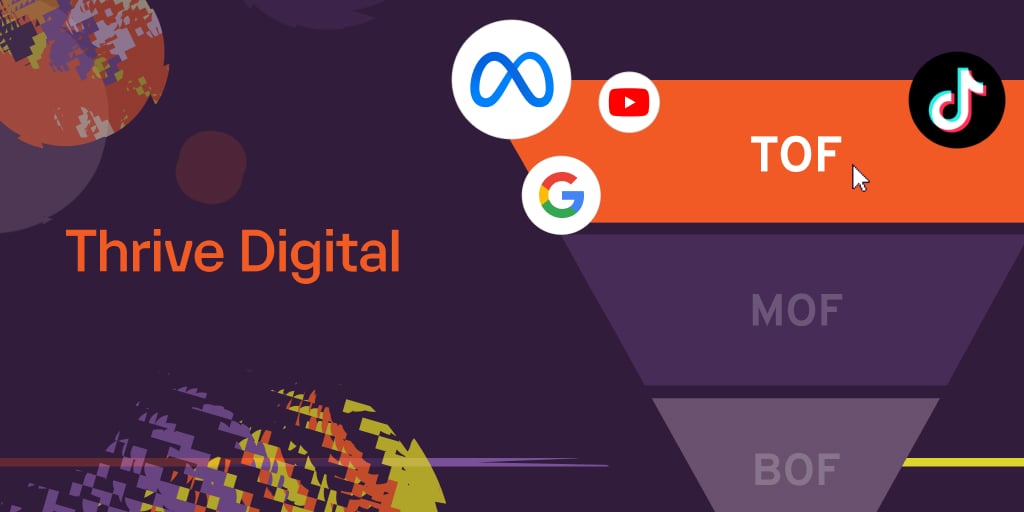
TL;DR DTC brands miss out on sustainable growth by investing exclusively in bottom-of-funnel initiatives. Google Ads offers easily accessible tactics to grow top-of-funnel investment, especially YouTube, which serves as a strong platform to grow your brand over time (along with a handful of other tactics like Amazon DSP, TikTok, and Connected Television (CTV)). Despite measurement challenges, strategies like brand lifts and incrementality studies can provide valuable insights to validate this spending. Investing in brand awareness, even with a modest budget, can create lasting growth.
I’m going to start with a bold claim and say most direct-to-consumer brands (or DTCs as we’ll refer to them here) aren’t spending enough money on top-of-funnel campaigns. Sure, DTCs usually have strict monthly sales targets and top-of-funnel campaigns can be tough to measure, but the long-term benefit shouldn’t be ignored.
We’ve seen some information to suggest that bidding for reach rather than conversion can lead to up to a 50% increase in incremental sales. That’s obviously not indicative of all campaigns or organizations but it’s sure interesting. To be more conservative in our estimates, take a look at this information from Nielsen,
“Compared with the alluring, immediate results of conversion-oriented marketing, brand building is slower to generate tangible returns. The returns, however, are meaningful—and measurable. In terms of actual sales, Nielsen’s experience base shows that on average, a 1-point gain in brand metrics such as awareness and consideration drives a 1% increase in sales. While it might be easy to dismiss a single percent as immaterial, a 1% return on sales of $1 billion equates to $10 million, which is far from immaterial.”
Stats aside, we know from working with our clients that top-of-funnel campaigns are a long-term investment into sustainable growth. Greater brand awareness means more ongoing sales long after the campaigns end.
One of the key strategies for testing top-of-funnel campaigns is to test a variety of channels where your audience is likely to be a user. As Google products are a part of so many people’s day-to-day lives, we've chosen to go over how DTC brands utilize Google across these campaigns. Many other channels are available and should be tested including (but definitely not limited to) Meta, TikTok, CTV, Display, Audio, DOOH, etc.
How DTC brands should be using Google for top-of-funnel campaigns
We believe DTC brands should specifically be utilizing Google for top-of-funnel (TOF) campaigns. For starters, there’s a practical advantage in tapping into the extensive user base on the platform. Given the widespread usage of Google, there’s a lot of good data on user behavior. Besides, most brands are already there for more bottom-of-funnel campaigns so a lot of the infrastructure is already set up and in place.
On top of the easy adoption, Google offers a suite of tools encompassing brand, search, and conversion lifts, consolidating testing and optimization within the platform. This integrated approach allows for efficient campaign refinement.
One other notable strength of Google is its versatility, catering to both top-of-funnel exposure, such as on YouTube, and mid-funnel strategies like Demand Gen campaigns. But enough theory, let’s dive into the tactics.
YouTube
We’re starting with YouTube because it’s the best top-of-funnel tactic for DTC brands. Specifically, video reach campaigns. What are they? Video and YouTube bumper ads, skippable in-stream ads, non-skippable in-stream ads, in-feed ads, or Shorts ads.
Why we like this tactic
For starters, video is a captivating and highly relevant format to all sorts of demographics today. It meets your audience where they’re already at, can tell interesting stories to make brand messaging feel less salesy and more like watchable content, and is a strong medium for awareness building.
It’s also one of our favorite top-of-funnel tactics because the audience targeting options aim to get in front of the right user, at the right micro-moment of their buying journey. YouTube offers audience targeting tools for high-intent audiences to help reach net new, highly qualified users, that otherwise wouldn't have heard or known about your brand/product. So it's not casting a wide net of unqualified reach, it refines the reach to qualified audiences.
How we recommend using it
The primary goal of this tactic is to increase brand awareness with a high reach. For this particular tactic, we strongly recommend targeting affinity audiences. These audiences are users chosen based on interests, habits, and preferences. It’s a great option when looking to expand upon your existing audience.
Another option we like is “in-market audiences” (people who have demonstrated interest in buying another product similar to the one you sell without previous awareness of your brand). Finally, we also recommend testing custom intent audiences, targeting people who've been searching for terms related to your product/service.
For detailed information on making your video creative as impactful as possible, check out this handy article our creative team wrote.
Demand Gen
Demand Gen campaigns are multi-format ads capturing engagement and action across YouTube (including Shorts), Discover (a part of Google Search showing people content related to their interests, based on their web and app activity), and Gmail.
Why we like this tactic
If you’re having trouble justifying jumping straight into top-of-funnel, and want to diversify slowly, Demand Gen is a great middle-of-funnel option. It builds overall awareness while still generating some immediate return on ad spend (ROAS).
With Demand Gen, you can also do some Brand Lift testing (but only through the YouTube functionality) so there is more in-platform measurability here.
How we recommend using it
Demand Gen can be used as a top-of-funnel strategy depending on the targeting method, optimization event, and creative. If pairing a high-funnel audience with a higher-funnel event and appropriate creative, it can be a low barrier to entry for a top-of-funnel campaign. We also suggest adding brand lifts to measure the campaign effect to see how users react to the brand for ad recall, awareness, and consideration.
Google Display
Google Display campaigns are where brands launch visual ads on Google’s Display Network (or GDN) including websites, apps, YouTube, Gmail, and more.
Why we like this tactic
Buying Display through Google Ads is a great way to get your brand in front of potential customers. It can allow you to disseminate ads across apps and websites on GDN and reach a lot of people at a relatively low cost.
How we recommend using it
For our clients, we’ve observed it’s a great way to reach people effectively if we’re using DV360 (programmatic and not typical Display bought through the Google Display Network). We find that DV360 has better targeting options and access to additional inventory. The benefit of the GDN is that it’s a low barrier to entry but the targeting just isn’t as strong so we recommend being careful to get the correct targeting focus on your brand’s ideal audience.
A few other options for DTC top-of-funnel campaigns
We’re mostly talking about Google today, but there are a lot of other good platforms and tactics to consider when building top-of-funnel traffic.
Amazon
The Amazon DSP (demand-side platform) offers great targeting options for DTC customers. You have access to all of Amazon's in-market categories for products and services plus if you're selling on Amazon, you can serve a combination of display/video on Amazon-owned properties - IMDB, Amazon.com.
TikTok
According to research from KnoCommerce, "Tiktok has rapidly grown as a key driver of product discovery from nearly zero in late 2020s to 9% in May 2022.”
This platform constantly growing and is a powerhouse for DTC and e-commerce brands. Creating awareness through good UGC (user generated content), lifestyle content featuring your product, and culturally relevant videos can help to generate a ton of brand awareness and ultimately, conversions. One other thing it’s important to mention here is that we now exist in a world where consumer journeys are more complex and their attention spans are shorter than ever before. Users are bombarded with content on multiple mediums (both digital and traditional) so getting their attention for more than 5 seconds is a coveted asset. TikTok is a gold mine for this.
Connected Television (CTV)
While CTV is a great option, in general, it is an extremely expensive form of advertising for most advertisers. YouTube is the easiest way to enter the space while targeting only CTV devices and has strong targeting capabilities for DTC specifically. When you start moving away from YouTube in the larger programmatic CTV space - things start getting pricey pretty quickly and any viable measurement strategy beyond clicks, impressions, reach, and frequency have minimum spends attached to them.
CTV at this stage is an alternative to linear TV and is a cheaper way of accessing this segment of the market. If your brand has a mature Google and social awareness strategy and is now looking for a premium place to serve ads, CTV is a good option.
Why are DTC brands shying away from top-of-funnel campaigns?
Aside from the strict sales targets that normally come with B2C products (specifically DTC brands), measurement and validation can be difficult for top-of-funnel campaigns. Unlike lower funnel campaigns with a more straightforward "dollar in - dollar out" measurement strategy, top-of-funnel campaigns are harder to measure. The in-platform metrics for these initiatives make it more challenging to discern their actual impact. Short-term studies, such as brand lifts, can help show metrics like brand awareness, but establishing a direct correlation to revenue is harder.
Not impossible, however, so let’s talk about measurement.
How to measure top-of-funnel campaigns
To steal from a blog we wrote on this topic, “5 ways to measure brand campaigns”, there are actually several good ways to measure top-of-funnel campaigns. Let’s look at 3 key ones here.
Ad platform surveys
One of the first recommendations is to conduct a brand lift study using YouTube. Within that study, you can ask up to three questions to understand how your campaign affects purchase intent and awareness without being tied to specific site actions.
Short-term leading indicators
While top-of-funnel ads aren’t meant to drive immediate sales, they can drive some immediately observable metrics that indicate long-term success and qualified users. Think reach increases across social platforms, increased qualified user activity on site, and overall traffic lift.
To go a step further, consider adding a search lift analysis. This helps you see the impact of your brand awareness campaigns on Search Engine Marketing (SEM) traffic.
Incrementality studies
For a more detailed picture, try an incremental study where you measure incremental impact. This structured test (like an A/B test) involves dividing your audience into two groups, serving ads to just one group, and then measuring the difference in outcomes. The benefit of this randomized control testing approach is that it’s the gold standard for understanding incrementality. The downside is the test results represent a specific moment and they may not translate into the future. Also, these tests demand a significant time investment, which can be difficult or impractical to build a proper control for measurement.
We wrote an entire blog on incrementality we recommend checking out for further context.
Metrics cover a wide range, from top-of-funnel stats like organic traffic to specific metrics like clicks, revenue, and conversions. These measurement tactics let you focus on real business impacts, steering clear of potentially skewed in-platform metrics. By embracing these strategies, you not only boost brand awareness but also gain valuable insights for future improvements.
A little investment goes a long way
Any efforts towards boosting your brand awareness go a long way to creating stable, long-term growth. You don’t need a massive budget either, just get out there and start testing. What happens if you double TikTok top of funnel spend for a month? What if you run highly qualified reach campaigns for a month on YouTube? Try out a variety of different tactics and have measurements in place to understand what success looks like for your brand.
And if all else fails, you can always email a talented performance marketing agency (us, we mean Thrive).
 Chris Erickson
Chris Erickson